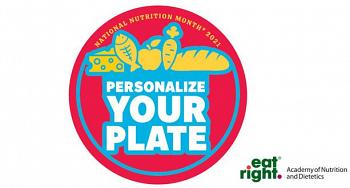Personalize Your Plate During National Nutrition Month
Every March, the Academy of Nutrition and Dietetics celebrates National Nutrition Month. The observance is an opportunity for people to learn how to make food and physical activity choices that better their lives, Marilyn Burch, Extension associate-foods and nutrition for the University of Arkansas at Pine Bluff, said.
One of the main reasons for celebrating is that healthy eating can be enjoyable and informative and not demanding, she said. This year’s theme, “Personalize Your Plate,” promotes creating nutritious meals to meet individuals’ cultural and personal food preferences.
“America is a cultural melting pot, so you can’t expect everyone’s food choices to look the same,” Su-Nui Escobar, a registered dietitian nutritionist and national spokesperson for the Academy of Nutrition and Dietetics, said in a press release. “Eating is meant to be a joyful experience. As supermarkets increasingly diversify their shelves to meet the needs of their customers, it’s becoming easier to create nutritious meals that align with a variety of cultural preferences.”
Burch said the National Food Month webpage available at www.eatright.org offers many resources for individuals who want to join the celebration and add some healthy habits to their lifestyle. The webpage is packed with helpful hints and options to cater to different personal and cultural preferences. For example, individuals can access printouts on ways to personalize their plates to include food from Asian Indian, Chinese, Filipino, Latin American and Middle Eastern cuisines.
As individuals plan for a healthy spring, Burch recommends they follow some main guidelines. This year, the Academy of Nutrition and Dietetics encourages people to take advantage of the following tips:
- Eat a variety of nutritious foods each day. Include healthy foods from all food groups and drink plenty of water. It is also important to remember to take time to enjoy your food and avoid distractions while eating.
- Plan your meals each week. Choose healthy recipes to make during the week and use a grocery list to shop for healthy foods. Remember to eat a healthy breakfast and healthy snacks – this will be your fuel for the day at work or school.
- Learn skills to create tasty meals. Keep healthy ingredients on hand and experiment with new flavors and foods. Share meals as a family when possible.
- Consult a registered dietitian nutritionist (RDN). Ask your doctor for a referral. The RDN will be able to address your unique needs and help you set and meet nutrition goals by providing individualized eating and activity plans.
Burch said the academy has also broken up general health and nutrition tips based on age group. In addition to maintaining healthful eating habits, individuals can follow these age-based tips:
- Teens to 20s — Build bone density by eating and drinking calcium-rich foods and beverages such as fat-free or low-fat dairy milk or yogurt or calcium-fortified soy beverages. Non-dairy sources of calcium include fortified cereals, beans, some leafy greens and canned salmon with bones.
- 20s to 30s — Reduce your risk of chronic diseases such as obesity, Type 2 diabetes and heart disease by eating more dietary fiber, including whole grains, legumes, fruits, vegetables, nuts and seeds. Women of childbearing age should include sources of folate, such as beans and peas and dark-green leafy vegetables, and eat foods fortified with folic acid such as breads, cereals and other grain products. A folic acid supplement may also be needed and should be discussed with a health care provider.
- 30s to 40s — Continue to eat a variety of nutritious foods, especially plenty of fruits and vegetables, whole grains and beans, peas and lentils for vitamins, minerals, antioxidants and dietary fiber.
- 40s to 50s — Fine tune your healthful eating habits and continue to incorporate regular physical activity as your body changes due to fluctuating hormones and slowing metabolism. Also continue to focus on ways to limit foods and beverages with added sugars, salt and saturated fat.
- 60s and beyond — Continue to include a variety of protein-rich foods to maintain bone strength and incorporate strength-building activities to maintain muscle. Good sources of protein include seafood, lean cuts of meat, eggs, beans, tofu and nuts. Animal-based protein foods also provide vitamin B12, which is important for older adults. Foods also may be fortified with vitamin B12 or a supplement may be recommended by your health care provider.
Burch said National Nutrition Month was initiated in 1973 as National Nutrition Week, and it became a month-long observance in 1980 in response to growing interest in nutrition.
“The month can be an open invitation for you to empower yourself through food and activity choices,” she said. “Keep in mind that developing a healthful eating pattern is not ‘one-size-fits all.’ By following the tips at www.eatright.org, people will be able to tailor their menus and activities to meet individual nutrient needs and personal and cultural preferences.”
The University of Arkansas at Pine Bluff offers all its Extension and Research programs and services without regard to race, color, sex, gender identity, sexual orientation, national origin, religion, age, disability, marital or veteran status, genetic information, or any other legally protected status, and is an Affirmative Action/Equal Opportunity Employer.




